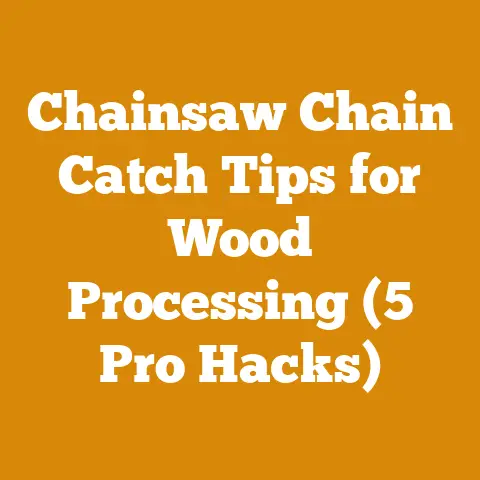How to Get Rid of Ants on Trees (7 Pro Tips for Woodworkers)
Did you know that ant infestations can cause structural damage to trees, costing homeowners and woodworkers thousands of dollars in repairs? As a seasoned woodworker and someone who’s spent countless hours felling, processing, and appreciating trees, I can tell you that discovering ants on your trees is more than just a nuisance—it’s a call to action. In this guide, I’ll share my time-tested methods for safely and effectively getting rid of ants on trees, ensuring the health and longevity of these vital resources. Let’s dive in and protect our trees!
Identifying the Ant Problem
Before I jump into solutions, it’s crucial to understand what you’re dealing with. Not all ants are created equal, and their presence on a tree can mean different things. Some ants are merely passing through, while others are setting up shop, potentially causing harm.
Types of Ants Found on Trees
First, let’s talk about the usual suspects. Carpenter ants are a major concern for woodworkers like me. These guys don’t eat wood; instead, they excavate it to build their nests. This can weaken the tree’s structure, making it susceptible to falling or breaking, especially during storms.
Then, there are pavement ants, which are more of a nuisance. They often nest in the ground but might climb trees in search of food. Similarly, acrobat ants can be found on trees, and they get their name from their habit of raising their abdomen over their heads when disturbed. They also nest in wood, albeit often in areas already damaged by moisture or other insects.
Signs of an Infestation
Identifying an ant infestation early can save you a lot of headaches down the road. Here are some signs to watch out for:
- Sawdust or Frass: Carpenter ants leave behind piles of coarse sawdust, often mixed with insect parts. This is a telltale sign they’re actively tunneling.
- Visible Trails of Ants: If you see a constant stream of ants marching up and down the tree, it’s a good indication they’ve established a colony nearby.
- Nesting Sites: Look for cracks, crevices, or holes in the tree where ants might be entering or exiting.
- Weakened Branches: Infested branches may become brittle and break easily.
Assessing the Damage
Once you’ve identified an infestation, take a close look at the extent of the damage. Are the ants confined to a small area, or are they spread throughout the tree? Is the tree showing signs of stress, such as yellowing leaves or stunted growth? This assessment will help you determine the best course of action.
My Experience: I once had a beautiful oak tree in my yard that was infested with carpenter ants. I didn’t realize the extent of the problem until a large branch fell during a windstorm. Upon closer inspection, I found extensive tunneling throughout the branch. That was a costly lesson in the importance of early detection and treatment.
Pro Tip #1: Natural Ant Repellents
When I’m dealing with ants, I always prefer to start with natural methods. These are not only safer for the environment but also less likely to harm the tree itself.
Diatomaceous Earth (DE)
Diatomaceous earth is a naturally occurring powder made from the fossilized remains of diatoms, a type of algae. It works by dehydrating insects, causing them to dry out and die. I recommend using food-grade DE, as it’s safe for use around plants and animals.
To apply DE, simply sprinkle it around the base of the tree and along any ant trails you see. You can also dust it directly into cracks and crevices where ants are nesting. Keep in mind that DE is only effective when dry, so you’ll need to reapply it after rain.
Application Metrics: Use approximately 1 cup of DE per square foot of soil around the base of the tree. Reapply every 1-2 weeks, or after rain.
Vinegar Solution
Vinegar is another effective natural ant repellent. The strong scent disrupts their trails and deters them from returning. I typically use white vinegar diluted with water in a 1:1 ratio.
To apply, pour the vinegar solution directly onto ant trails and around the base of the tree. You can also spray it onto the trunk and branches, but be careful not to oversaturate the leaves, as vinegar can be harmful to some plants.
Application Metrics: Mix 1 cup of white vinegar with 1 cup of water. Apply liberally to ant trails and nesting areas. Reapply every 2-3 days, or as needed.
Citrus Peels
Citrus peels contain a compound called d-limonene, which is toxic to ants. To use citrus peels, simply place them around the base of the tree or grind them up and sprinkle them along ant trails.
I often use orange or lemon peels, as they have a strong scent that ants find unpleasant. You can also make a citrus spray by boiling citrus peels in water for about 10 minutes, then letting the mixture cool and straining it into a spray bottle.
Application Metrics: Use peels from 2-3 citrus fruits per tree. Replace the peels every 1-2 weeks, or when they start to decompose.
My Insight: I’ve found that combining these natural repellents can be particularly effective. For example, I might sprinkle DE around the base of the tree, then spray the trunk with a vinegar solution. This creates a multi-layered defense that ants find difficult to overcome.
Pro Tip #2: Create Physical Barriers
Sometimes, the best way to get rid of ants is to prevent them from accessing the tree in the first place. This can be achieved by creating physical barriers that they can’t cross.
Tree Bands
Tree bands are sticky barriers that wrap around the trunk of the tree, preventing ants from climbing up. I prefer using commercially available tree bands, as they’re designed to be non-toxic and won’t harm the tree.
To install a tree band, simply wrap it around the trunk at a height of about 2-3 feet from the ground. Make sure the band is snug against the bark, with no gaps where ants can sneak through. Check the band regularly and remove any debris or insects that get stuck on it.
Installation Metrics: Wrap the tree band tightly around the trunk, ensuring full contact with the bark. Check and clean the band every 1-2 weeks.
Copper Tape
Copper tape is another effective barrier against ants. Ants are repelled by copper, so they won’t cross it. I use copper tape to protect smaller trees or individual branches.
To apply copper tape, simply wrap it around the trunk or branch, overlapping the edges slightly. Make sure the tape is clean and free of any residue that might allow ants to cross.
Installation Metrics: Overlap the copper tape by at least 1/2 inch to ensure a continuous barrier. Replace the tape every 6-12 months, or as needed.
Pruning Branches
Sometimes, ants can access trees by climbing overhanging branches that touch other plants or structures. Pruning these branches can eliminate a major pathway for ants.
I always make sure to prune branches carefully, using sharp, clean pruning shears. Cut the branches back to the nearest branch collar, avoiding flush cuts that can damage the tree.
Pruning Metrics: Prune branches at a 45-degree angle, about 1/4 inch away from the branch collar. Sanitize pruning shears with rubbing alcohol before and after each use.
My Experience: I once had a client who was struggling with an ant infestation in their apple tree. After installing a tree band and pruning overhanging branches, the ant problem disappeared within a few weeks. It’s amazing how effective these simple barriers can be.
Pro Tip #3: Boric Acid Baits
Boric acid is a naturally occurring compound that’s toxic to ants. It works by disrupting their digestive system, causing them to die. I use boric acid baits to target ant colonies directly.
Homemade Boric Acid Bait
To make a homemade boric acid bait, mix 1 teaspoon of boric acid with 1/2 cup of sugar and 1 1/2 cups of warm water. Stir the mixture until the sugar and boric acid are dissolved.
Soak cotton balls in the boric acid solution and place them in small containers or lids. Place the containers near ant trails or nesting areas. The ants will be attracted to the sugar and will carry the boric acid back to their colony, eventually killing the entire nest.
Mixing Metrics: Use a ratio of 1 teaspoon of boric acid to 1/2 cup of sugar and 1 1/2 cups of water. Replace the bait every 2-3 days, or as needed.
Commercial Boric Acid Baits
If you prefer, you can also purchase commercial boric acid baits. These are typically pre-packaged in small containers and are designed to be placed near ant trails.
Follow the instructions on the product label carefully. Place the baits in areas where ants are active, and check them regularly to make sure they haven’t run out of bait.
Application Metrics: Place baits every 5-10 feet along ant trails. Check and refill baits every 2-3 days, or as needed.
Safety Precautions
When using boric acid, it’s important to take safety precautions. Boric acid can be harmful if ingested, so keep it out of reach of children and pets. Wear gloves when handling boric acid, and avoid getting it on your skin or in your eyes.
Safety Tips: Store boric acid in a locked cabinet, away from food and cleaning supplies. Wash your hands thoroughly after handling boric acid.
My Advice: I’ve found that patience is key when using boric acid baits. It can take several weeks for the ants to carry the bait back to their colony and eliminate the entire nest. Don’t give up if you don’t see results immediately.
Pro Tip #4: Insecticidal Soap
Insecticidal soap is a safe and effective way to kill ants on contact. It works by disrupting their outer protective layer, causing them to dehydrate and die.
Application
To use insecticidal soap, simply spray it directly onto the ants. Make sure to cover them thoroughly, as the soap only works on contact. You can also spray it onto ant trails and nesting areas.
I typically use a commercially available insecticidal soap, as it’s formulated to be safe for plants. However, you can also make your own by mixing 1 tablespoon of liquid dish soap with 1 quart of water.
Mixing Metrics: Use 1 tablespoon of liquid dish soap per quart of water. Apply liberally to ants and nesting areas.
Frequency
Reapply insecticidal soap every 2-3 days, or as needed. It’s important to note that insecticidal soap only kills ants that are present at the time of application. It doesn’t provide any residual protection, so you’ll need to reapply it regularly to keep the ant population under control.
Application Metrics: Reapply every 2-3 days, or after rain. Monitor the ant population and adjust the frequency as needed.
Precautions
While insecticidal soap is generally safe for plants, it can be harmful to some species. Before applying it to an entire tree, test it on a small area first to make sure it doesn’t cause any damage.
Also, avoid spraying insecticidal soap on beneficial insects, such as bees and ladybugs. These insects play an important role in the ecosystem, and you don’t want to harm them.
Safety Tips: Test insecticidal soap on a small area of the tree before applying it to the entire plant. Avoid spraying beneficial insects.
My Observation: I’ve noticed that insecticidal soap is most effective when used in combination with other ant control methods. For example, I might use it to kill ants on contact, then follow up with boric acid baits to target the colony.
Pro Tip #5: Beneficial Nematodes
Beneficial nematodes are microscopic worms that parasitize insects, including ants. They work by entering the ant’s body and releasing bacteria that kill it.
Application
To use beneficial nematodes, simply mix them with water and apply them to the soil around the base of the tree. The nematodes will then seek out and infect any ants that are present in the soil.
I typically purchase beneficial nematodes from a garden supply store. Follow the instructions on the product label carefully, as the application process can vary depending on the species of nematode.
Mixing Metrics: Follow the instructions on the product label for mixing nematodes with water. Apply to the soil around the base of the tree.
Frequency
Reapply beneficial nematodes every 4-6 weeks, or as needed. They are most effective when the soil is moist, so water the area thoroughly after application.
Application Metrics: Reapply every 4-6 weeks. Keep the soil moist after application.
Advantages
One of the main advantages of using beneficial nematodes is that they are safe for the environment. They only target insects and won’t harm plants, animals, or humans.
Additionally, beneficial nematodes can provide long-term ant control. Once they’ve established themselves in the soil, they will continue to kill ants for several months.
Benefits: Safe for the environment, provides long-term ant control.
My Success: I once used beneficial nematodes to control an ant infestation in my vegetable garden. Within a few weeks, the ant population had decreased significantly, and my plants were thriving.
When to Call a Professional
I recommend calling a pest control company if:
- The ant infestation is severe and widespread.
- You’ve tried multiple DIY methods without success.
- You’re concerned about the health of the tree.
- You’re not comfortable handling pesticides.
Choosing a Pest Control Company
When choosing a pest control company, it’s important to do your research. Look for a company that is licensed, insured, and has a good reputation. Ask for references and read online reviews.
Also, make sure the company uses safe and effective treatments. Avoid companies that use harsh chemicals that can harm the environment or your health.
Selection Criteria: Licensed, insured, good reputation, uses safe and effective treatments.
Treatment Options
Pest control companies offer a variety of treatment options for ant infestations. These may include:
- Spraying: Applying pesticides to the tree and surrounding area.
- Baiting: Placing ant baits near ant trails and nesting areas.
- Dusting: Applying insecticidal dust to cracks and crevices.
- Soil Treatment: Treating the soil around the base of the tree with pesticides.
The best treatment option will depend on the type and severity of the ant infestation. Your pest control technician will be able to recommend the most appropriate course of action.
Treatment Options: Spraying, baiting, dusting, soil treatment.
My Recommendation: I always recommend getting multiple quotes from different pest control companies before making a decision. This will allow you to compare prices and services and choose the company that’s right for you.
Pro Tip #7: Maintain Tree Health
One of the best ways to prevent ant infestations is to keep your trees healthy. Healthy trees are less susceptible to pests and diseases, and they’re better able to withstand the damage caused by ants.
Watering
Water your trees regularly, especially during dry periods. Trees need adequate moisture to thrive, and drought stress can make them more vulnerable to pests.
I recommend watering deeply and infrequently, rather than shallowly and frequently. This encourages the roots to grow deeper into the soil, making the tree more resilient.
Watering Metrics: Water deeply and infrequently, allowing the soil to dry out slightly between waterings.
Fertilizing
Fertilize your trees in the spring with a balanced fertilizer. This will provide them with the nutrients they need to grow and stay healthy.
Follow the instructions on the fertilizer label carefully, and avoid over-fertilizing, as this can damage the tree.
Fertilizing Metrics: Fertilize in the spring with a balanced fertilizer, following the instructions on the label.
Mulching
Mulch around the base of your trees to help retain moisture, suppress weeds, and regulate soil temperature. I recommend using organic mulch, such as wood chips or shredded bark.
Apply a layer of mulch that is 2-4 inches thick, and keep it several inches away from the trunk of the tree to prevent rot.
Mulching Metrics: Apply a 2-4 inch layer of organic mulch around the base of the tree, keeping it several inches away from the trunk.
Pruning
Prune your trees regularly to remove dead, damaged, or diseased branches. This will improve air circulation and sunlight penetration, and it will also help prevent pest infestations.
I recommend pruning in the late winter or early spring, before the trees start to grow. Use sharp, clean pruning shears, and make clean cuts to avoid damaging the tree.
Pruning Metrics: Prune in the late winter or early spring, using sharp, clean pruning shears.
My Insight: I’ve found that maintaining tree health is the most important factor in preventing ant infestations. Healthy trees are simply less attractive to ants, and they’re better able to defend themselves against attack.
Conclusion:
Dealing with ants on trees requires a multifaceted approach. By understanding the type of ants you’re dealing with, employing natural repellents, creating physical barriers, using boric acid baits, applying insecticidal soap, introducing beneficial nematodes, seeking professional help when needed, and maintaining overall tree health, you can effectively manage and eliminate ant infestations. Remember, consistent monitoring and proactive measures are key to protecting your trees and ensuring their long-term health. I hope this guide has provided you with the knowledge and confidence to tackle any ant problem you encounter. Now, let’s get to work and keep our trees thriving!






